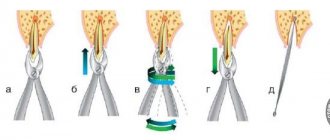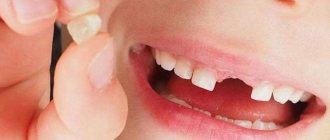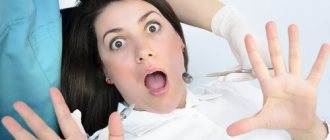Tooth extraction is one of the oldest procedures in dentistry. If previously it was practically impossible to pull out a tooth without blood and pain, today dental offices have all the necessary medications and instruments to make this procedure quick and painless for both children and adults.
You can pull out a tooth both in the clinic and at home, but it is important to understand that the procedure involves surgical intervention and is risky for those who do not have special knowledge. There are many indications for tooth extraction, but the main one is the replacement of baby teeth or a chronic infection that destroys the root and permanent tooth, and harms the entire oral cavity. Many patients come to us because of pain in the area of their wisdom teeth. In many cases they are also removed.
How to pull out a baby tooth without pain
A baby is born without teeth because he does not need to chew food - breast milk or formula passes easily into the stomach.
At four to five months, the first milk teeth appear, which gradually fall out at five to seven years, being replaced by permanent teeth. You don’t have to go to the dentist to pull out a loose tooth—you can do it at home in a variety of ways. Before the procedure, it is important to make sure that the milk jug is ready for removal and that the child has no contraindications. Also, do not forget about cleaning the oral cavity after the procedure.
Loose teeth - reasons
The main provoking factors of pathological mobility of dental units can be:
- Inflammatory and non-inflammatory gum diseases - gingivitis, periodontitis, periodontal disease. One of the most common causes of mobility.
- Chronic diseases: psoriasis, diabetes, thyroid dysfunction, some types of metabolic disorders, arthritis, osteoporosis.
- Disturbances in the functioning of the immune system.
- Bite pathologies.
- Hereditary predisposition.
- Hypovitaminosis and hormonal changes.
- Taking certain medications.
- Advanced root caries and other types of “dental” diseases (periodontitis, cyst, granuloma, etc.).
- Injuries, bruxism, unhealthy diet, bad habits.
In addition, in cases where the front teeth are loose, we can talk about non-compliance with hygiene standards - in the absence of proper care, hard plaque accumulates in the root part of the teeth, which gradually provokes inflammation of the gums and disruption of the dentogingival bonds.
If you have a problem similar to that described in this article, be sure to contact our specialists. Don't diagnose yourself!
Why you should call us now:
- We will answer all your questions in 3 minutes
- Free consultation
- The average work experience of doctors is 12 years
- Convenient location of clinics
Single contact phone number: +7
Make an appointment
Having noticed the high mobility of their own dental units, many people are interested: if a tooth is loose, can it be saved? It all depends on the cause of mobility, the degree of oral health and the general condition of the body. In any case, timely visit to the dentist significantly increases the chances of preventing edentia.
When can you pull out a child’s baby tooth at home?
Changing teeth is a natural and necessary process of development of the maxillofacial apparatus. The peculiarity of the structure of milk jugs is that they have short nerve roots, which makes their loss painless. In most cases, changing milk jugs occurs independently and does not require outside intervention. It is possible to remove a temporary tooth in cases where it is well loosened, but at the same time it interferes with speaking and chewing. In such situations, it is permissible to carry out the manipulation at home without visiting a doctor.
How to understand that you can pull out a child’s baby tooth:
- there is no pain or blood when the milkman staggers;
- healthy pink gums;
- the tooth moves easily back and forth in the hole;
- no stomatitis, gingivitis, tonsillitis;
- The child feels well and is healthy.
Problems arising from missing teeth
The absence of even one dental unit in a row leads to serious consequences:
- Due to the lack of lateral support, neighboring teeth begin to shift;
- if a tooth is lost along with the root, the bone tissue in this area begins to quickly atrophy and decrease;
- chewing function is impaired, which leads to problems with the gastrointestinal tract;
- the bite changes, which leads to deformation of the position of the jaw joint and dysfunction of the umbilical nervous system;
- The shape of the face changes, the upper lip begins to recede, and wrinkles appear.
The longer a tooth is missing, the more severe the consequences will be. If a tooth is lost in the smile area, patients are offered different options for restoring the dentition. The method depends on the clinical picture.
Contraindications to tooth extraction at home
Before choosing a method to extract a tooth yourself, it is important to make sure that this manipulation will not cause harm. The presence of the following manifestations is a contraindication for removing thrush at home:
- redness of the gums;
- strong adhesion of the tooth to the jaw;
- thickening of the gums due to swelling;
- the presence of blood or pain when the milkman staggers;
- increased body temperature, signs of acute respiratory viral infection, sore throat;
- the child has severe fear.
When performing a manipulation, you cannot hold the child by force, otherwise the fear of performing procedures in the mouth will remain for life. In all doubtful and complex cases, you should contact a specialized specialist - a pediatric dentist.
Children often experience carious lesions in primary teeth, leading to their partial destruction. Such situations require a mandatory visit to a doctor with subsequent treatment or removal. Even severely damaged carious teeth cannot be pulled out on your own - this will lead to pain and injury to the gums and lips.
If the front tooth is destroyed, but the root is preserved
In case of significant destruction of the coronal part (up to 50%), the front tooth can be restored using prosthetic crown. The affected tooth is depulped, followed by filling the canals, given the desired shape (prepared), if necessary, the root is strengthened with a stump insert. The crown is fixed onto the prepared stump using dental cement.
For the smile area, it is better to choose all-ceramic or metal-free crowns made of zirconium or aluminum oxide. These materials have a shade and degree of transparency similar to natural enamel. The doctor will select an option so that the restored tooth does not stand out in any way in the general row.
Preparing a child for tooth extraction
Before pulling out a child’s tooth, it is important to carry out psychological preparation - explain in a calm voice the essence of the procedure and its purpose, emphasizing that it is not painful and quick. You can come up with a fairytale story about the milkman's journey or tell that mom and dad also had their temporary teeth pulled out.
You also need to ask the child to swing the tooth as much as possible with his tongue - this will make it possible to quickly pull it out of the gums. When the milkman wobbles, its short nerve endings are torn off or pulled out of the canals, so there is no pain syndrome.
How are gingivitis and periodontitis treated in a child?
Inflammatory diseases of the gum tissue can very quickly lead to loosening of permanent teeth. Therefore, it is so important not to miss the early symptoms of periodontitis in children - first of all, swelling of the gums and the appearance of blood when brushing teeth and eating solid foods.
The main cause of the development of inflammatory diseases is soft plaque, which remains due to poor quality teeth cleaning. Over time, it hardens, forming supra- and subgingival tartar. Hard periodontal deposits first cause inflammation of the mucous membrane, then the process covers periodontal tissue and bone tissue. “Dissolved” tissues no longer fix the permanent tooth, and it becomes loose. If treatment is not started, the child's teeth will fall out.
In some children, periodontitis may be caused by a lack of blood supply to the tissues. This usually occurs in the absence of the necessary chewing load. Parents should ensure that their children eat enough solid vegetables and fruits. In addition, it is necessary to bite and chew food not on one side of the dentition, but on both. In this case, the load on the teeth will be distributed evenly.
Treatment of gums begins with the removal of soft plaque and tartar, for which professional teeth cleaning for children is performed. Anti-inflammatory therapy is then prescribed according to the severity of the disease. In some cases, splinting of teeth is indicated - a procedure that prevents their further loosening. At the clinic, the child will be taught how to brush his teeth correctly, and the parents’ task will be to carefully monitor hygiene procedures at home and, if necessary, brush their son or daughter’s teeth.
Carrying out the procedure, simple tips
On the Internet you can find a lot of advice on removing temporary teeth, containing both descriptions of traditional methods and absurd proposals using improvised means. It is always important to think about the safety of the action for the child’s health and the possible consequences; it is better to give preference to one of the following two methods:
- use fingers and a handkerchief;
- apply thread.
Regardless of which manipulation it is decided to remove the milk duct, both participants in the procedure need preliminary preparation aimed at preventing infection. Before pulling out a baby tooth, an adult should thoroughly wash their hands with soap, and a child should rinse their mouth with warm water.
You can remove the milk jug like this: take a clean cloth, grab it and sharply pull it up if the tooth grows from the lower jaw or down if it grows from the upper jaw. This manipulation usually scares children, so they often resort to a more popular method. How to pull out a child's baby tooth using floss:
- Position the light source so that the oral cavity is well illuminated.
- Take a nylon thread about 30 cm long; tie one end to the loose tooth, making 4–5 turns around it; wrap the other around the index and middle fingers of an adult.
- Make a sharp movement with your hand, jerking your hand down if the milk duct grows on the upper jaw or upward for cases where the tooth is on the lower jaw.
Tooth extraction, if all conditions are met, takes no more than 5 minutes and is not accompanied by pain or other unpleasant sensations. Correctly performed manipulation does not leave the child afraid of the dentist and manipulations in the oral cavity.
Tips on how to pull out a tooth yourself correctly:
- position the thread so that it does not touch the lip, otherwise there is a risk of injury;
- do not use improvised means and tools;
- make sure the milk jug is ready to be removed.
If the tooth is well loosened, but the child is afraid to remove it with floss or fingers, and does not want to go to the doctor, you can give it an apple to chew on - solid food will cause the duct to fall out quickly and without pain.
What not to do for tooth loss
When a child complains of a loose tooth, parents should not use methods to remove it, based on funny videos from the Internet:
- Do not tie one end of the string to a tooth and the other to a door handle, bicycle, or anything else. This method will not work if the tooth is firmly seated, but will only bring pain and psychological trauma to the child. There is also a high probability of removing only part of the tooth, without the root;
- tweezers, clamps, rope, pliers and other tools are also not suitable for the procedure, since carelessness can injure and frighten the child;
- moving the tooth left and right - this injures the gums, causing bleeding and causing discomfort to the child.
Have you ever helped your child loosen a tooth? Or does he do it on his own? Share interesting stories in the comments.
Main photo: 1000sovetov.ru.
Oral hygiene after tooth extraction
Immediately after you have pulled out the tooth, you need to moisten a cotton ball with chlorhexidine and place it in the hole for 10 minutes. If a small amount of blood appears, then use hydrogen peroxide for these purposes - it not only disinfects, but also helps stop minor bleeding.
To form a full-fledged blood clot, as well as to prevent food particles from getting into the wound and causing infection, after the manipulation the child is not allowed to eat or drink for 2 hours. Please note that alcohol and vodka are not used to treat wounds in children.
Further care after baby tooth extraction:
- On the first day, brush your teeth without touching the socket with the brush. You should not use a paste - its components will irritate the wound surface.
- Rinse your mouth with chamomile decoction and a weak soda solution 4-5 times a day for 5-7 days. It is imperative to carry out this procedure after eating to remove food debris - otherwise an inflammatory process may develop.
- Eliminate salty, spicy and hard foods from the diet for 5 days. These products have an aggressive effect on the mucous membrane and can cause bleeding from the socket and pain.
- In children with frequent inflammatory diseases of the oral cavity, a warm antiseptic solution of furatsilin can be used for rinsing.
Author: Zhukov M.A.
What to do after tooth loss
Finally, the tooth gave in and left the gum! But it’s too early to relax - you need to properly treat the wound. A small hole now appears in the place where the tooth was. At first it will bleed, so you need to stop this process:
- rinse your mouth with an antiseptic solution;
- examine the hole from the fallen tooth to make sure that no roots remain there, and the help of a doctor is not required to extract them;
- put a piece of gauze or cotton wool into the wound and bite it to stop the bleeding;
- do not eat food for an hour and give up spicy, salty and sour foods for a while.
If after half an hour the bleeding has not been stopped, and you suspect that part of the tooth remains in the mouth, then seek help from a dentist as soon as possible.
Not all children are able to easily cope with tooth loss. The parents' task is to explain to the child that this is a natural process. A good way to do this is to have a conversation where you can say that tooth loss means growing up. To reinforce a positive attitude towards changing baby teeth, you can exchange lost teeth for nice little things or sweets. Parental support is also important, so under no circumstances should you tease your child with a toothless child.
pixabay.com
Why is it dangerous to leave a tooth root in the gum?
- The inflammatory process in it has not stopped, the danger of inflammation of the jaw tissue increases;
- Caries can spread to neighboring teeth;
- ENT diseases may develop.
The root of the damaged tooth must be removed. This is a complex procedure that requires the use of antibacterial drugs and anesthesia. It should be performed by an experienced doctor.
Removing tooth roots on your own is dangerous, as it is difficult to remove them completely. In addition, there is a high risk of infection of the hole.
You can solve this problem yourself only under certain conditions:
- The damaged tooth is very loose;
- It’s impossible to get to the dentist’s office, and the tooth hurts unbearably.
What risks exist:
- Inflammation may develop;
- The root can only be partially removed;
- Possible heavy bleeding.
Do not use the door handle for removal. Safe removal is possible only after systematic loosening.
To do this with minimal risk of tissue damage and infection, you need to follow a number of recommendations.
- Assess the situation - whether you can cope with the task. If the tooth is tightly fixed, is it worth starting extraction? A tooth that is tightly held cannot be removed.
- A loose tooth should be further loosened with the tongue. Perhaps it will fall out on its own.
- Before attempting to extract the root, wash the flour, brush your teeth with toothpaste, and rinse your mouth with a disinfectant (rinse) to ensure maximum disinfection. You can use special solutions. It is important that they contain alcohol.
- Use of painkillers. The painkiller should not cause side effects. For the drug to take effect, you must wait at least half an hour.
What do you need to know?
The procedures for removing baby and molar teeth are similar, but the latter are fixed in the tissues much more firmly and deeper. Before removal, make sure that the problem comes from this particular tooth. If there is blood during removal, you need to use tampons soaked in antiseptic.
After removal, you need to remove parts of the tooth and blood from your mouth, wash your hands, and apply cold to the injury site to reduce the risk of swelling. Over the next few days, you should stop smoking and avoid heavy physical activity.
You cannot pull a tooth out on your own without pain. This effect can only be achieved by professional pain relief. If the removal was successful, monitor the hole for a week. If suppuration or swelling appears, use an antiseptic and rush to the doctor. If, having started the removal, you cannot complete the process, there is severe pain, stop immediately and go to the hospital. Until this time, do not load the tooth or eat food.
The dentist must be informed:
- When the tooth was removed;
- When did the pain start?
- What means were used?











